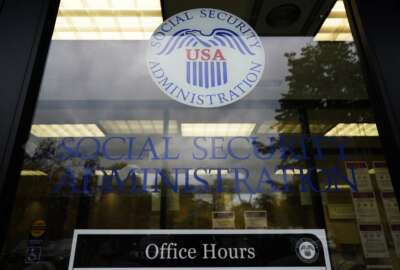DHS activates Surge Capacity Force as Helene batters southeast US
DHS Secretary Mayorkas activated the federal employee volunteer force “due to the anticipated frequency and severity of extreme weather this season."
The Department of Homeland Security has activated a volunteer force of federal employees to potentially reinforce the Federal Emergency Management Agency as it responds to Tropical Storm Helene.
In a message to DHS employees on Thursday, Homeland Security Secretary Alejandro Mayorkas directed the activation of the Surge Capacity Force “due to the anticipated frequency and severity of extreme weather events this season.” He specifically pointed to Hurricane Helene’s expected impact on the southeastern United States this week.
“I urge you to join and register for this critical initiative,” Mayorkas wrote. “This is an opportunity collaborate with other federal agencies, grow your personal and professional skills, and serve your fellow Americans in moments of extraordinary need.”
The Surge Capacity Force is comprised of more than 7,800 federal employee volunteers. It is typically called on to help augment FEMA’s full-time workforce, as well as its cadre of reservists.
“We are very grateful for all our partners within the federal interagency for their support for that,” FEMA Administrator Erik Hooks said during a press call today. “That gives us additional personnel that we begin immediately training and [have] ready to deploy to wherever the needs may be. This is a regional level event, and so we want to be prepared with the prerequisite amount of personnel.”
DHS and FEMA did not immediately respond to questions about how many volunteers may be called up under the Surge Capacity Force’s activation.
As of Saturday evening, more than 3,200 FEMA staff and other federal partners had deployed to assist with the Helen response.
Helene made landfall as a category four hurricane in the “Big Bend” region of the Florida panhandle late Thursday night. Ken Graham, director of the National Weather Service, noted that Helene remained a hurricane for about six hours, until 5 a.m. Friday morning, before being downgraded to a tropical storm as it tore through Georgia.
“The tropical storm force winds were sustained all the way to upstate South Carolina, which is really just amazing extent of the winds in the storm,” Graham said. “And several times the tropical storm force was extended 350 miles or so away from the center, which is pretty staggering.”
Officials said they were tracking more than 4 million people without power across the southeastern United States as of late Friday morning.
Surge Capacity Force
Congress created the Surge Capacity Force in 2006 in the wake of Hurricane Katrina. Any permanent, full-time federal employee at the GS-15 level or below can volunteer with the force. But becoming a member requires sign-off from a supervisor, as does an actual deployment to aid FEMA response efforts.
DHS last activated the Surge Capacity Force in 2022 in response to Hurricane Ian.
FEMA uses federal volunteers in a variety of positions, ranging from IT and logistics to processing survivor assistance applications. Deployments typically do not exceed 45 days.
This month’s activation of federal volunteers comes as FEMA’s chronic staffing shortages continue.
The agency for years has struggled to maintain a workforce large enough to respond to a growing number of natural disasters. The Government Accountability Office reported that FEMA was short about 6,200 staff of its requirements at the beginning of fiscal 2022.
Federal response to Helene
In addition to FEMA’s response efforts, the Coast Guard has more than 8,400 personnel responding in the aftermath of Helene, according to Vice Adm. Nathan Moore, commander of the Atlantic Area for the Coast Guard.
“Number one, we are responding to the urgent distress to save lives and assist the folks that were impacted by this storm,” Moore said during the press call today. “And then, of course, we’re concerned about the safety of our own first responders and others. And then next, we’re focused on conducting post storm assessments to support the rapid reopening of those impacted ports and to restore the marine transportation system and support the arrival of life saving aid. And then fourth is to support our interagency state and local partners with post storm actions in accordance with their authorities and emergency declarations.”
Meanwhile, the Army Corps of Engineers has mobilized 71 civilians, 34 military service members, and about 170 contractors, according to Brig. Gen. Daniel Hibner, commanding general of the South Atlantic Division for the U.S. Army Corps of Engineers.
With the remnants of Helene expected to drop heavy rain across the Cumberland River Basin this weekend, the Corps of Engineers has also prepared for potential flooding.
“Our reservoirs have plenty of flood capacity, and actually we were in drought stage in some of our river systems, so this is actually helping in terms of water levels,” Higner said during the press call today. “We’re working with the Coast Guard on surveying ports so that the Coast Guard can open their ports. … Our levees in the region are performing as designed and are in good shape.”
Meanwhile the Department of Health and Human Services Administration for Strategic Preparedness and Response (ASPR) pre-positioned approximately 200 responders to help states support public health and medical needs, according to Jonathan Greene, the director of ASPR’s Center for Response.
“We also position tons of medical equipment and supplies to support our teams in the field,” Greene said. “We have additional personnel on alert, and they are ready to deploy to the area should Florida or any of the other states need additional resources to support local healthcare in those communities.”
The Virginia National Guard has also staged approximately 20 soldiers and tactical trucks, along with two Black Hawk helicopters, in preparation for Helene.
Copyright © 2024 Federal News Network. All rights reserved. This website is not intended for users located within the European Economic Area.
Follow @jdoubledayWFED






